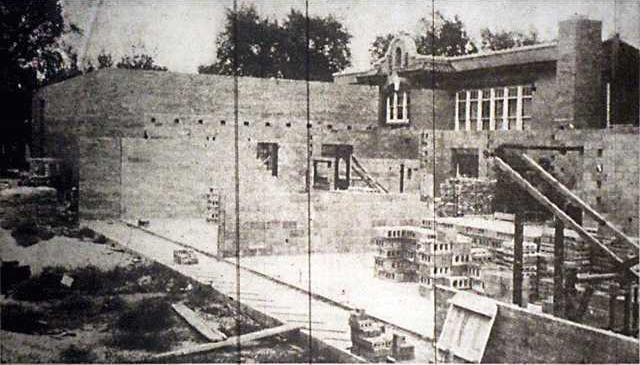Each week we’ll take a step back into the history of Great Bend through the eyes of reporters past. We’ll reacquaint you with what went into creating the Great Bend of today, and do our best to update you on what “the rest of the story” turned out to be.
This week is the 60th anniversary of the devastation wrought heavy rains from Hurricane Diane. According to Wikipedia, “the hurricane caused $754,706,000 in damage (1955 USD), of which $600 million was in New England,[1] making it the costliest hurricane in American history at the time.”
Readers of The Great Bend Tribune learned more than 130 people were killed due to flooding in eight east coast states when they sat down to read their Sunday paper. Already, President Eisenhower had declared six states disaster areas, and asked the American people to be generous to the Red Cross.
“An urgent appeal for flood disaster relief funds was received by Barton County Red Cross Chapter Chairman Earl Immenschuh Thursday...(he) said all Barton Countians are urged to mail or bring contributions to the local chapter office on the fourth floor of the courthouse, designating the funds for flood relief...President Eisenhower (said) donors shouldn’t wait to be asked by the Red Cross but “should seize the opportunity to force upon them more than they can use.”
In later reports, the story of a typhoid scare unfolded as problems with getting clean water, food and necessities into the stricken areas became apparent. Many roads were washed out, as well as other crucial infrastructure.
Back to school
But back at home, teachers were gearing up for the start of school which would happen in a few weeks, and every district in the readership checked in with their progress. Retailers were ramping up their back-to-school campaigns, and upcoming sales meant a particularly thick paper.
Riley Elementary School was in the middle of a new five classroom addition, and it wasn’t going to be ready by the time school started Sept. 6. The addition would also include the multipurpose room that acts as a gym, lunchroom, and auditorium. Delays delivering building materials was cited as the reason. Luckily, the addition of two new rooms in the old area would be completed in time for the fall term, bringing the old building up to 15 rooms. Now, 60 years later, the school continues to be a valuable property to the district, especially after investing in a new HVAC system in 2014.
Hero worship
Summer’s last hurrah for the kids could be found at the Royal Theater, where “The Kentuckian,” starring Burt Lancaster, was showing. It was “the story of the great American adventurer...The Frontiersman!”
The New York Times had nothing good to say about the film, other than there were a few good outdoor scenes shot in color and in Cinemascope that made it feel like a big picture. But others thought it was a good family film. And, it offered yet another opportunity for boys to get out their coonskin hats and pretend to be like Davy Crockett. Perhaps it’s only coincidence, but Great Bend’s Montgomery Ward advertised a whole line of Davy Crockett inspired toys, clothes, and miscellaneous items.
Lancaster’s last role in a major Hollywood film was with Kevin Costner in Field of Dreams, playing Dr. Archibald “Moonlight” Graham. That was in 1989. He would pass away five years later from a heart attack.
Electric thinking
Forward thinking and innovation were on the minds of one Central Kansas Electrical Cooperative, which took out a full-page ad in the Tribune, reprinting a story from the paper from the front page of the Aug. 15 Great Bend Tribune, “AEC Grants Central Kansas Coop Access To Atomic Energy Data.” The ad header declared “Research is the Answer.” The gesture certainly cost a pretty penny, and underscored the point the headline made.
According to the story, “The big coop, serving 4,500 consumers in the nine counties of the Golden Belt area, is the largest rural electric system in Kansas,its generators, located a mile west of Great Bend, use natural gas as a fuel.”
But the board was keeping an open mind about the newest fuels that could power tomorrow, and wanted to be on the cutting edge of technology.
In 1981, Central Kansas Electrical Cooperative was purchased by Central Kansas Power Company, Inc., and the two companies merged to become Midwest Electric. which today continues to serve the area’s rural electric customers. Atomic energy was later correctly referred to as nuclear energy. There is only one nuclear power plant in Kansas, Wolf Creek Station in Coffey County.
Just peachy
Nothing says summer like peaches. That’s what one unidentified person must have been thinking when they stopped to pick the low-hanging fruit from the tree in Grover Gillstrap’s back yard at 1623 Stone Street. Fortunately for Gillstrap, the fruit picker left payment in the form of several coins adding up to an unknown figure that his wife felt smug about, telling the reporter, “Let them worry about how much they lost.” The couple continued to enjoy their home, and probably plenty more peaches, for many years after. Mrs. Gilstrap passed away in 1959, and Mr. Gilstrap at the age of 80 in 1971.
Out of the Morgue
Summer wrap up and back to school in 1955





